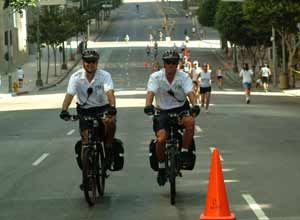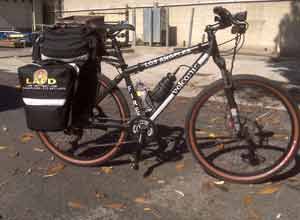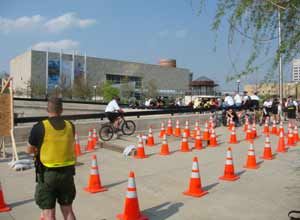By Robert Dunivin
IPMBA EMS Basic cyclist instructor
 Photo Rick MCclure Bikes from the Los Angeles Fire Department on patrol at the LA Triathlon. |
The key to the Emergency Medical Service is early treatment and transport as well as early access to ALS intervention. Fire and EMS providers across the country deal with routine response issues on a daily basis. However, the challenge to the routine is providing this rapid response during extreme crowds and in densely populated areas — and on a shrinking budget.
EMS Bicycle Teams have become a popular answer to these challenges.
Bike Medic programs are found in large cities and small towns across the country. There are full-time teams daily deployed to high traffic in downtowns and airports. Most teams are part-time and used for special events and unique response issues. Some teams deploy every weekend, and others just once or twice a year.
Public Safety Cycling started first in the law enforcement world. The modern day debut of public safety bike teams was in the 1980s by the Seattle Police Department. Shortly after police bike units hit the streets, their success became very evident — attracting the attention of EMS providers.
The benefit of being able to carry EMS equipment while having maneuverability in large crowds, tight areas and high traffic congestion became of great interest to Fire and EMS Providers. Another plus was the fact that they could get to the call faster than if they were on foot.
The first known fire department to purchase bikes for medical response use was the Indianapolis Fire Department in 1984 — and in 1989 they formally formed a team. Today there are more than 300 Bike Medic teams across the country staffed by fire departments, private ambulance services and public EMS providers.
The benefits of the bike
In the almost three decades of EMS bike teams, most medical units are primarily used for special events, some have been deployed on a more routine basis. These teams have experienced many benefits.
| It is about the bike There are a few things to consider with bike selection. Hard Tail frame mountain bikes are the standard in EMS bike teams. EMS Panniers are designed to attach to a rigid frame. Most attachment systems would not be compatible with full suspension bikes. Hard tails are typically less expensive than full suspension bikes. Select a combination tire for your bike. Aggressive tread dirt tires will number one; be a waste of money and number two, add drag to the bike. While any hard tail will do, there are some manufacturers that make and market bikes specific to police and EMS use. With silent hubs, rear racks, tires, and emergency lighting/siren systems (a must for moving the crowds out of your way). Prices range on these bikes like any other bike you would buy. The range goes from a little more than $300 to $2000. Obviously, you get what you pay for. You want to keep this in mind when purchasing. You also want to use a reputable manufacturer. To evaluate what range you want to spend, you need to consider your budget, frequency of use, and your maintenance program and replacement program. Also evaluate the amount you will use the bikes, if you only deploy once or twice a year you probably don’t need the $2000.00 bike. If you are going to deploy every weekend, your $400.00 bike won’t last but 6 months to a year. The LAFD treats our bike like our fire engines, spend a little more, treat it good, and keep it for a long time. Therefore we found with the amount of use and the length we keep them it was a better value for us to buy a higher end bike. |
The first and foremost is reduced response times. In Los Angeles during holiday deployments to Los Angeles International Airport, the LAFD — my department —found that the average response time was between 1 and 2 minutes in the terminal areas. The closest rescue ambulance during extreme traffic congestion could take up to 15 minutes for a response that would usually take them between 4 to 5 minutes. During events where foot teams and bike teams are both deployed, bike teams will typically have half the response time of the foot team.
Another benefit is mobility. Bike Medic teams can navigate crowds, curbs, stairs, escalators, and elevators with great ease. Segways, golf carts, and utiity vehicles such as Mules and Gators will not be able to negotiate all of these obstacles.
Cost savings can be considered another benefit. Most bike teams can be put together for way less than the cost of a new ambulance; many of these teams can start up for less than the cost of a Mule with a MED BED. London Bike Medic teams actually saved the London Ambulance Service $160,000 in 2007 — $4,000 of that was in fuel savings.
Meeting the public
One often overlooked benefit, though very important, is public relations. Even though Fire and EMS personnel are typically more popular with the public than law enforcement, they are not as accessible to the public. With the exception of fire prevention inspections, grocery shopping and the occasional trip to Starbucks, the majority of public contact comes during emergencies. Bike Medic teams being deployed to street fairs, festivals, and races are very well received by the public. The teams are usually right in the mix of the event and are very approachable. Additionally, people enjoy the “green” aspect of the Bike Medic program. They feel we are trying to do our part to protect the environment and save fuel.
How to have a successful program
Funding is the first and foremost item to deal with. You need to figure out startup costs like training, uniforms, bikes and equipment as well as the ongoing costs for bike maintenance and replacement, uniform replacement and continued training . Turning to the community, local bike shops and manufacturers will help you defray some of the startup costs. There are grants specifically available for police bike programs; however there are no specific EMS bike program grants. There have been some creative grant writers that have received money for EMS, however. The director of FEMA has promised to make more grants available for EMS programs — hopefully this will mean grants specific to EMS bike programs. This will probably take some time, so in the meantime research local grants from bike coalitions, as well as your state, for more alternative funds.
A key component to a successful bike program is defining the program’s parameters and objectives. What level of service can the team provide, ALS or BLS? Do you want your team to be part-time, full-time, or combination? This will depend on the size of your community, the size of your company or department, and the type of issues you may have. Do you provide EMS services for a stadium, race track, airports, or congested urban areas? Do you provide EMS services to occasional street festivals and parades — or do you have both? Will your team be involved in Search and Rescue? This will also help you determine the type of equipment and staff you will need.
Selecting the right gear
The inventory you’ll need is based on whether your team is ALS or BLS, and if the agency that regulates your program has special requirements. The L.A. County Department of Health Services has a required inventory list for a Paramedic Assessment Resource. Other counties have chosen not to regulate bike teams. The inventory may vary, but O2, AED, bandages, ice packs, IVs, and ALS Drugs are the most common. You won’t be able to carry large inventories. There are panniers specifically made for bike teams with large areas for O2 bottles and AEDs as well as see thru pockets for other equipment.
A professional looking uniform is the first impression the public sees. A Bike Medic uniform has to be professional yet functional. Typically it’s recommended you wear a polo-type shirt and shorts (convertible pant short combo a good choice) made of breathable materials for active use. Some uniform manufacturers make bike patrol specific uniforms. Many will have reflective trim to provide additional safety for night deployments. Bike helmets, riding gloves, and glasses are a needed part of the uniform as well. There should be a uniform spec whether you provide them or have the members provide their own.
 Photo Robert Dunivin Typical EMS Bike ready for response.
|
How to train your team
Of all the previous items to consider, training can make or break your team. A properly trained team not only looks professional but reduces the chance for injury to your members and the public. All of the good PR that your team has built up can be trashed because of one headline that reads “Bike Medic Mows down Three-Year-Old at Local Parade”. The quickest way to get your team in trouble is by not having a legitimate training program.
Many teams have turned to their local law enforcement agency for help. They have provided a great basis to develop programs. Most law enforcement programs are POST certified, which means they have certain guidelines they have to follow. However, while a good part of their course will deal with skills for EMS bikes, a great deal of their program will not be applicable. Visiting neighboring programs is always helpful, and continued networking with the other teams is beneficial to all. Talk to several, though, because you will find all levels of programs out there.
You can avoid reinventing the wheel by contacting a national organization that deals specifically with public safety bike teams. The largest organization for this is the International Police Mountain Bike Association. IPMBA was originally started as a law enforcement bike officers association. Over time, it saw the need to expand from just law to EMS personnel and security officers. IPMBA developed a 32- hour EMS Basic Cyclist course. This course is a nationally recognized curriculum and certification, developed by individuals with many years of experience. IPMBA offers the course every year at their annual conference as well as upper level classes. Check out the Web site for a list of locations where the EMS Basic course is being offered and for a list of instructors in your town. IPMBA in conjunction with publisher Jones and Bartlett developed and published The Complete Guide to Public Safety Cycling, the manual for many bike courses.
 Photo Robert Dunivin Bike Team training at the IPMBA conference in Indianapolis.
|
Once you have your team up and running, a continued training program (especially if you only deploy the team a few times a year) and ongoing maintenance is an important part in keeping your team active and successful. Additionally, looking for new uses for your team and public relations activities will keep the team in the spot light and have people requesting that “Bike Medics” be at their event.
With a modest investment in equipment and a proper training program, your Bike Medic program will not just become something you do, but something your department or company is known for. A top notch program will allow your agency to provide rapid EMS and early ALS intervention no matter what the circumstances or venue you may be responsible for.
Robert Dunivin has 20 years experience in the fire service, the last seven with the Los Angeles Fire Department. He has held the positions of Firefighter and Engineer with two separate departments. Robert is the co-chair of CSFA’s Health and Wellness Committee. Robert is also a Certified IPMBA EMS Basic cyclist instructor. Robert has been with the Los Angeles Fire Department’s Bike Medic team since its inception more than five years ago. He can be reached by email at rdunivin@csfa.net.

